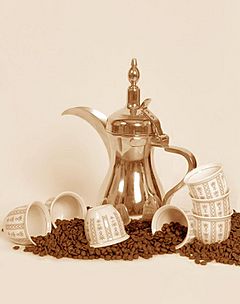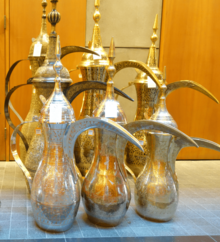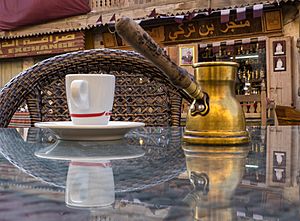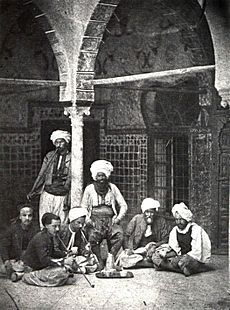Arabic coffee facts for kids

A dallah is a traditional Arabic coffee pot with cups and coffee beans.
|
|
| Alternative names | Qahwah arabiyya |
|---|---|
| Type | Coffea arabica |
| Course | Drink |
| Place of origin | Yemen |
| Region or state | Arab World, Middle East |
| Associated national cuisine | Arab cuisine |
| Invented | 15th century |
| Serving temperature | Hot |
Arabic coffee is a special type of coffee made from Coffea arabica beans. Many Arab countries in the Middle East have their own unique ways of making it. Often, a spice called cardamom is added, but you can also have it plain or with sugar.
There are different ways to brew Arabic coffee, making it lighter or darker depending on what people like. It usually tastes bitter, and people typically don't add sugar. It's served in a small, decorated cup called a finjān. Arabic coffee is an important part of culture, often served during family get-togethers or when guests visit.
This coffee is a big part of Middle Eastern and Arab traditions. It started in Yemen in the Middle East and then traveled to places like Mecca, Egypt, and Levant. By the mid-16th century, it reached Turkey and then Europe, where coffee also became very popular. UNESCO has even recognized Arabic coffee as an Intangible cultural heritage for Arab states.
Contents
The History of Arabic Coffee

The story of coffee often begins with a legend about an Ethiopian goat herder named Kaldi. He noticed his goats became very energetic after eating berries from a certain tree. He tried the berries himself and felt more awake. At first, people chewed the coffee beans, but later they learned to roast them and make a drink.
Many historians believe coffee first came to the Arabian Peninsula around 675 AD. By the mid-1400s, it was used in Yemen by Sufi monks. They drank it to stay awake during their prayers at night. From Yemen, coffee spread north to holy cities like Mecca and Medina, and then to big cities like Cairo, Damascus, and Baghdad. It reached Constantinople (now Istanbul) in the 1500s.
For a short time, some religious leaders tried to ban coffee because of its stimulating effect. But these bans were later overturned, and coffee continued to spread.
How Arabic Coffee is Made

Arabic coffee is made from coffee beans that are roasted lightly or sometimes more heavily. It's often mixed with cardamom. Traditionally, the beans are roasted, ground, and brewed right where they will be served, especially for guests. It's usually offered with sweet treats like dates, dried fruit, or nuts.
Arabic coffee is known for how it's prepared and its flavors, not just the type of beans. It's a boiled coffee that isn't filtered, so it's black. Sugar is usually not added, making it bitter. To balance this, it's often served with something sweet, like dates.
It's served in a small, handle-less cup called a finjān. Sometimes, the coffee is poured from a special, beautiful pot called a dallah in front of guests. Other times, the host prepares it in the kitchen and brings out a tray of small cups. Unlike Turkish coffee, traditional Arabic coffee, especially from Bedouin traditions, is usually unsweetened.
Coffee in the Arabian Peninsula

People in the Arabian Peninsula have creative ways of making coffee. Their coffee is different from that in Egypt or Levant, especially in how bitter it is and the cups it's served in. This way of brewing is common in Najd and Hejaz. Sometimes, other spices like saffron (which gives it a golden color), cardamom, cloves, and cinnamon are added.
Arabic coffee in Najd and Hejaz often has a golden color. In North Arabia, there's a type called qahwah shamālia (Northern Coffee), which is darker because the beans are roasted longer. This Northern coffee is also known as Bedouin coffee in Jordan.
It's prepared and served from a special pot called a dallah. Another common pot is the cezve (also called rikwah or kanaka). The cups are small and have no handles. The servings are tiny, just covering the bottom of the cup. It's served in homes and good restaurants by special waiters called gahwaji, and it almost always comes with dates. It's always offered as a sign of welcome.
Coffee in the Levant
In the Levant region, including Palestine, coffee is a popular drink throughout the day. Arabic coffee is similar to Turkish coffee, but it's spiced with cardamom and usually unsweetened. Among Bedouins and most other Arab people in Palestine, bitter coffee, called qahwah sadah (plain coffee), is a symbol of hospitality.
Serving the coffee is a special ceremony. The host or their oldest son moves around the guests, pouring coffee into tiny cups from a brass pot. Guests are usually expected to accept three cups of coffee. After the third cup, they can politely say daymen, which means "always," but here it means "may you always have coffee to serve."
In Lebanon, coffee is made in a long-handled coffee pot called a "rakwe." It's then poured directly into a small, decorated cup called a finjān. Lebanese coffee is traditionally strong and black, similar to coffee in other Middle Eastern countries. However, it uses a mix of light and dark roasted beans, ground into a very fine powder.
In Jordan, Arabic coffee is more than just a drink; it's a traditional sign of respect and a way to bring people together. Black, cardamom-flavored Arabic coffee, also known as qahwah sādah (welcome coffee), is deeply rooted in Jordanian culture. Offering coffee (and tea) to guests is a big part of the warm hospitality in Jordan.
Coffee in Morocco
While Maghrebi mint tea is the national drink of Morocco, Arabic coffee is also widely enjoyed, especially for formal events. It's often served when making business deals, welcoming someone to your home for the first time, or at weddings and other important occasions.
Coffeehouses: Places to Meet and Talk
The idea of coffeehouses started in the Arab world. These places became popular spots for people to meet, socialize, play games, drink coffee, and enjoy water pipes (shisha).
Traditional Arab coffeehouses were often called "Schools of the Wise" because they became places for important discussions, as well as for relaxing and making friends. In the Maghreb region, green tea with mint is often served, or coffee in Arab or European styles. In Egypt and the Levant countries, Arabic or Turkish coffee is common. Arabic coffee is a small amount of dark coffee, boiled and served in a tiny cup. In Egypt, coffee is often served mazbuuta, meaning it has "just the right" amount of sugar.
In the Arabian Peninsula, Arabic coffee is roasted so lightly that it's almost clear. Throughout the Arab world, it's a tradition for the host to keep refilling a guest's cup until the guest politely signals they've had enough.
How Arabic Coffee is Served
Arabic coffee is usually served in very small amounts, just a few sips at a time. The guest drinks it, and if they want more, they don't do anything. The host or waiter will keep pouring small amounts until the guest signals they are finished. Often, people drink only one cup, as serving coffee is a special act of kindness and hospitality. Sometimes, people drink more during long conversations.
Customs and Traditions
The cups are usually filled only partway, and it's customary to drink three cups. Arabic coffee is very important during traditional Arab holidays and special events like Ramadan and Eid.
Fortune-telling with Coffee
Some people believe they can tell the future by reading Arabic coffee cups. This is called qirāʾat al-finjān. After drinking most of the strong coffee, a small amount of liquid and thick coffee grounds are left in the cup. The cup is then turned upside down on a saucer to let the liquid drain. The reader then looks at the patterns formed by the coffee grounds inside the cup, searching for symbols and letters to interpret.
Coffee at Funerals
At Arabic funerals, families and relatives gather. They drink bitter, unsweetened coffee and share stories about the person who passed away. Men and women usually gather separately. It's common to have people whose job is to serve coffee all day to the guests. Both Arab Muslims and Christians share this tradition.
Nutrition Facts
A small cup of Arabic coffee has almost no calories or fat. It contains a very small amount of protein.
Images for kids
See also
 In Spanish: Café árabe para niños
In Spanish: Café árabe para niños










